120 videos match your search.
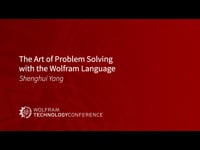 |
Shenghui Yang This talk continues a previous discussion of solving more complex problems in every major branch of mathematics using Wolfram Language, including how Wolfram Languae can help with understanding the fundamentals and applying generalizations with very limited amounts of code based on built-in functions and the community-driven Wolfram Function Repository. Mathematica users can easily go beyond the problem itself ... |
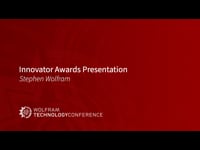 |
Stephen Wolfram |
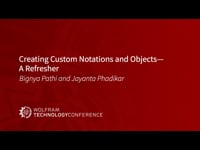 |
Bignya Pathi and Jayanta Phadikar This talk presents a comprehensive walk-through of the techniques for creating custom notations and objects with Wolfram Language as they relate to typesetting. It includes a short introduction of object-oriented ... |
 |
Paul Abbott, PhD Anyone interested in education innovation has many reasons to attend Wolfram Summer School, including most especially those mentioned in this discussion. |
 |
George Woodrow III The Wolfram Language has a number of useful controls, but has no circular slider. In this presentation, I show how I developed one, going from an example in the documentation ... |
 |
Brad Janes and Steven Lachowski As Wolfram|Alpha Notebook edition turns two, we're showing off all of the educational and fun new features that we have added over the last year. In addition to many ... |
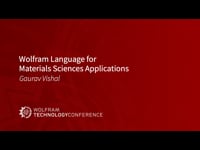 |
Gaurav Vishal This talk discusses how Wolfram Language can be used for modeling and analysis in materials science including the following function topics: Molecule; LatticeData and related functions; ImageProcessing to analyze microstructures; ... |
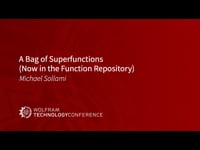 |
Michael Sollami This presentation is a discussion of this specific user's participation authoring and submitting functions for the Wolfram Function Repository, including examining use cases, some function history, and practical, real-world applications. |
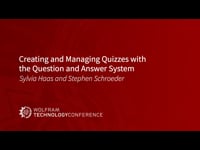 |
Sylvia Haas and Stephen Schroeder Educators, come see the new and expanded teaching tools in Version 13! Get a first look at the new Q&A Form Notebook and the powerful new features in the Question and Answer system. Discover how to easily create coursework with tools for automated assessment ... |
 |
John Cassel This talk gives a view into the ongoing stream of development aimed at improving how the Wolfram system handles biometric data. Topics include released functionality and work in development. |
 |
Peter Barendse, Daniel McDonald, Jack Heimrath and Xiaofan Zhang We present updates to the automated geometric functionality of the Wolfram Language introduced in Version 12 and display new functionality for automated geometric reasoning. |
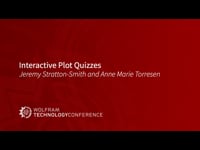 |
Jeremy Stratton-Smith and Anne Marie Torresen The latest version of Wolfram|Alpha Notebook Edition includes a set of interactive self-driven quiz functions, the first set of which revolves around function plotting for high school/early college ... |
 |
Rodrigo Obando This talk presents a model of cellular automata that includes the ability to examine genetics and a particular gene's effect on a rule or set of rules. |
 |
Olivier Rousselle We consider an atomic system (hydrogen) where we want to observe interference fringes. To do that, we use a small mirror in which the atoms will perform quantum bounces (due to the confinement between gravity and Casimir–Polder potential). We use Mathematica to implement quantum bounces. Such system can be generalized ... |
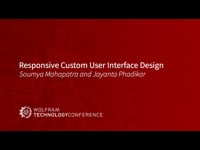 |
Soumya Mahapatra and Jayanta Phadikar This talk discusses various tips and tricks for using Wolfram Language to create fast and responsive custom user interfaces. |
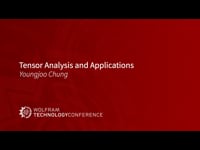 |
Youngjoo Chung This presentation shows an add-on package that facilitates symbolic computation in Mathematica for tensor analysis. This add-on, MathSymbolica, contains over 1,000 functions and its own interpreter language for notation, manipulation and ... |
 |
Chi-Ok Hwang Thanks to MathSymbolica based on Mathematica and developed by Prof. Youngju Chung in Korea, my last-passage algorithm Green function development has been very easy. The symbolic computing becomes complicated as we go from dipole, quadrupole and octupole. However, ... |
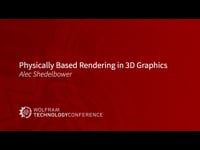 |
Alec Shedelbower Learn how to achieve more realistic graphics with physically based rendering (PBR) in the Wolfram Language. PBR is an approach to rendering that attempts to model the behavior of light ... |
 |
Jason Biggs This talk will showcase new functionality for working with the Molecule, a symbolic representation of a chemical species introduced in Version 12 of the Wolfram Language. Topics will include seamless integration ... |
 |
Jon McLoone This talk demonstrates a web-based application designed to automate the performance of DSE reviews built using Wolfram Application Server, explains the application architecture and discusses issues such as user authentication, ... |